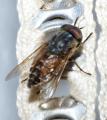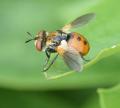Diptera.info :: Identification queries :: Diptera (adults)
Who is here? 1 guest(s)
|
Pollenia ID
|
|
| Carnifex |
Posted on 21-08-2019 21:27
|
|
Member Location: Vienna, Austria Posts: 1861 Joined: 23.06.15 |
Hi, is it possible to ID this female based on the photos provided? Found in a garden in Vienna, Mid August. Length: 7,5mm. The posterior spiracle is yellow and there are some light hairs on the ventral hind femur    
Edited by Carnifex on 30-11-2021 08:28 Cheers, Lorin Font Color All requests are from the urban area of Vienna, if not otherwise stated. My Diptera observations (and other living forms) can be found here, and corrections or comments over there would also be appreciated. |
|
|
|
| johnes81 |
Posted on 21-08-2019 21:58
|
|
Member Location: Berlin, Germany Posts: 1978 Joined: 15.10.16 |
Hello Lorin, check the wing for pediculata (tuft of pale hairs) https://diptera.info/photogallery.php?photo_id=10761 Best wishes, John John and Nini. Naturalists not experts. |
|
|
|
| Carnifex |
Posted on 21-08-2019 22:21
|
|
Member Location: Vienna, Austria Posts: 1861 Joined: 23.06.15 |
I checked it, it's bare.
Cheers, Lorin Font Color All requests are from the urban area of Vienna, if not otherwise stated. My Diptera observations (and other living forms) can be found here, and corrections or comments over there would also be appreciated. |
|
|
|
| johnes81 |
Posted on 21-08-2019 22:29
|
|
Member Location: Berlin, Germany Posts: 1978 Joined: 15.10.16 |
Hello Lorin, then you will need to dissect the ovipositor for dorsal and ventral views. Pollenia are difficult and features are unreliable (Rognes). You can learn more by reading documents available from Dr. Rognes: http://www.knut-rognes.no/PIZ.html a few photos and an id request doesn't work with Pollenia. Best wishes, John John and Nini. Naturalists not experts. |
|
|
|
| Carnifex |
Posted on 27-08-2019 21:22
|
|
Member Location: Vienna, Austria Posts: 1861 Joined: 23.06.15 |
Thanks John, I bookmarked the Rognes-site for future reference. So, I can only hope these fotos are sufficient for an ID, otherwise this fly has to remain at genus level.  
Edited by Carnifex on 30-11-2021 08:28 Cheers, Lorin Font Color All requests are from the urban area of Vienna, if not otherwise stated. My Diptera observations (and other living forms) can be found here, and corrections or comments over there would also be appreciated. |
|
|
|
| johnes81 |
Posted on 27-08-2019 22:44
|
|
Member Location: Berlin, Germany Posts: 1978 Joined: 15.10.16 |
Hello Lorin, The ovipositor is not opened up for dorsal and ventral views (see my example photo of P. rudis ovipositor attached to this reply), so it is complicated now. Tergites and sternites are missing in addition to this matter. All hope is not lost because you have the lateral sacs in tact. Do you still have the lateral sacs? and do you have the spermathecae? I have an appointment in the morning, so i must sleep soon. I am telling you this because i will start from scratch with this species. I will rekey it to place it into a proper group, then continue from there. I think that it is of the rudis group and that means it should be angustigena or hungarica because of the golden hairs on the abdominal tergites and the femora 2 and 3. Again, All hope is not lost. I will examine all of this material and any additional photos of my requested lateral sacs and spermathecae. Then we will reach a species. I will return tomorrow agternoon or evening. Best wishes, John ps I am happy that you bookmarked the site. I am sorry for not getting back to you via email. I have been busy but i am a man of my word. I will write to your email tomorrow as well. Until then, goodnight. johnes81 attached the following image:  [53.12Kb] Edited by johnes81 on 27-08-2019 22:44 John and Nini. Naturalists not experts. |
|
|
|
| johnes81 |
Posted on 28-08-2019 12:00
|
|
Member Location: Berlin, Germany Posts: 1978 Joined: 15.10.16 |
Hello Lorin, I've keyed this to the rudis group. I exclude hungarica for a few reasons but mainly because of the strongly curved lateral sacs. Thus, we are left with angustigena and rudis. It is complicated now because many features really are unreliable. golden hairs would indicate angustigena but there should be more of them and i am not convinced that it isn't a lighting effect. In photo 1, i see no golden hairs on either femora t2 or t3. Despite any golden hairs, angustigena usually only has one ad on the mid tibia. Your speciman has two ad. I think that it is easier to find a rudis with a few golden hairs (i have two specimens with this feature) than it is to find angustigena with more than one ad. I suggest that you stick with Pollenia cf rudis female. "careful observation and adequate lighting conditions are necessary, as it is not always easy to appreciate colour of hairs as distinct from colour of light reflected from them" - Dr. Rognes In the future, you are welcome to send Pollenia specimens to me for examination. I really don't mind. I love Pollenia. I am happy to help. Keep this in mind. Best wishes, John Edited by johnes81 on 28-08-2019 12:04 John and Nini. Naturalists not experts. |
|
|
|
| johnes81 |
Posted on 28-08-2019 12:10
|
|
Member Location: Berlin, Germany Posts: 1978 Joined: 15.10.16 |
Hello Lorin, as promised, i've sent an email to the address that you have sent to me. I hope that you have a splendid day. try to stay cool in these high temperatures. Best wishes, John John and Nini. Naturalists not experts. |
|
|
|
| Carnifex |
Posted on 28-08-2019 22:00
|
|
Member Location: Vienna, Austria Posts: 1861 Joined: 23.06.15 |
Thanks a lot John, I received it. This will make things easier I hope. Only once before I aimed at getting a Pollenia IDed, and I was lucky as it turned out to be P. pediculata, which even got identified from photos of the living specimen. However, I just started to dissect male genitalia, so female ones was new for me, and I didn't focus much on anything else then the last segments. But I made a stack from the complete dissected material, where the lateral sacs are included.  Cheers, Lorin Font Color All requests are from the urban area of Vienna, if not otherwise stated. My Diptera observations (and other living forms) can be found here, and corrections or comments over there would also be appreciated. |
|
|
|
| johnes81 |
Posted on 28-08-2019 22:57
|
|
Member Location: Berlin, Germany Posts: 1978 Joined: 15.10.16 |
Hello Lorin, my opinion doesn't change with the latest photo but it is a better photo, so i can see what has happened: you didn't fully extend the ovipositor. Some of the tergites are still available. Use fine forceps to hold the cerci then use fine forceps to grab the end near the lateral sace. Carefully extend the ovipositor that remaining tergites/sternites are visible. Perhaps we can see enough to come to a final conclusion. Best wishes, John John and Nini. Naturalists not experts. |
|
|
|
| Jump to Forum: |













 but don't see the image in the post.
but don't see the image in the post.
